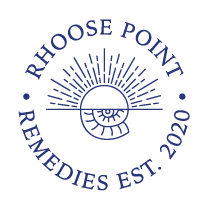How to groom your dog AT HOME
Grooming your dog is an integral part of a dog care routine. Without a proper grooming routine, our precious pups are susceptible to nasty diseases and illnesses.
Learning how to groom your dog at home helps keep them looking and feeling their best and can prevent many health problems that could otherwise cause serious health risks.
The benefits of regularly grooming your dog:
- Prevents illness and disease
- Gets rid of any matted hair, dirt, dandruff and trapped debris
- Cleans their teeth to prevent any dental problems
- Keeps your dog looking nice and clean
- Prevents other dogs from becoming dirty too
- Protects your household interior from getting dirty
- Prevents smelly breat
Some dog breeds require more specialised grooming such as haircuts and styling to maintain the appearance of that specific breed but there are many other elements of grooming that you can do at home.
Learning how to groom your dog will not only keep them looking and feeling their best but it will also strengthen the bond between you both and get them used to being handled, which makes every trip to the vet that much easier!
grooming your dog at home includes:
Grooming your dog means taking care of their whole outer body. Grooming your dog goes way beyond brushing.
Dog grooming includes:
- Brushing
- Bathing
- Dental care
- Nail trimming
- Ear cleaning
Ready to learn how to groom your dog? We’ve put together a short guide with some useful grooming tips.
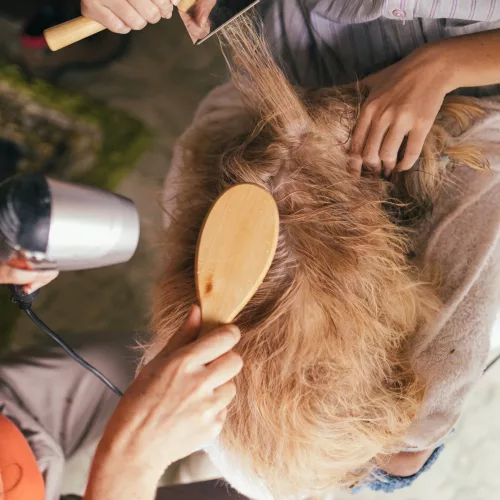
1. brushing your dog
The most regular activity on the grooming list should be brushing your dog’s coat and is the easiest way to get started when grooming your dog at home.
Brushing your dog removes loose hair and prevents matting and tangling of fur which not only helps your dog avoid irritation but prevents excess shedding around your home.
It also stimulates the skin, promoting blood circulation and distributing natural oils in the fur leading to a healthier skin and coat.
This is also a prime opportunity to catch any skin abnormalities early. Check for bumps or lumps under the skin or any redness of the skin. Keep an eye out for anything that may be causing your dog some discomfort too such as ticks, fleas or other parasites.
To brush your dog’s coat efficiently, remember to:
Invest in a good quality dog grooming brush that suits your dog’s coat
Slick brushes work better for long haired dogs. Bristle brushes are usually better for shorter haired dogs. Read more about the best type of brush to buy for your dog’s coat
We like the Bamboo Dog Double-sided Grooming Brush. It’s sustainable, reusable and recyclable and can be used for most dog breeds. It effectively removes dead hair, helps to maintain a healthy coat, and can be used at bath time too.
Choose an appropriate time to groom your dog
You may want to set a specific time each week and a location in your home where your dog feels comfortable and relaxed. Grooming your dog at home when there is a lot of noise or energy around may not be the best option. Pick a time when you and your dog can be calm and relaxed.
Brush your dog in the direction of the hair growth
Always brush your dog in the direction of the hair growth working in short strokes from top to bottom. It doesn’t really matter whether you start from the head or the back of your dog but a top down approach works best for loosening hair effectively.
Brush gently and avoid pulling hair. Focus on areas that may need a little more work to avoid matting such as behind the ears, under the legs and belly and around the tail.
Remember to also keep checking the brush and removing the gathered hair from the brush to keep the brush strokes effective.
Remove any tangles or mats
If you notice a tangle or any matted hair in your dog’s coat, do not pull on the fur with the brush. Instead, try to isolate the matted fur away from your dog’s skin and patiently start to untangle the hair at the edges of the mat.
You can create your own detangling spray by mixing a small amount of dog conditioner or olive oil with water in a spray bottle. Give it a good shake and spray on the tangle of fur.
Once the matt is sprayed it may be easier to untangle. Use picking motions with your fingers, or a detangling comb, gradually untangling the matted hair from the outside in.
If you find a mat that you can’t untangle yourself, contact your dog groomer who will help to safely remove the mat from your dog’s fur.
Brush regularly to keep the coat in top condition
How often you brush your dog’s will depend on your dog’s breed. For example, shorter haired dogs such as Dalmatians and Boxers may not need to be brushed as often as longer haired breeds like Shih Tzus or OId English Sheepdogs. Whilst curly haired dogs like Bichon Frises will need more regular brushing to help maintain their curls and avoid matting.
It’s also important to remember your dog’s lifestyle when considering how often to brush your dog’s coat. If you and your best friend spend a lot of time outdoors and they like to get dirty then you may need to brush your dog’s coat more regularly to keep it in top condition.
Slick brushes work better for long haired dogs. Bristle brushes are usually better for shorter haired dogs. Read more about the best type of brush to buy for your dog’s coat
We like the Bamboo Dog Double-sided Grooming Brush. It’s sustainable, reusable and recyclable and can be used for most dog breeds. It effectively removes dead hair, helps to maintain a healthy coat, and can be used at bath time too.
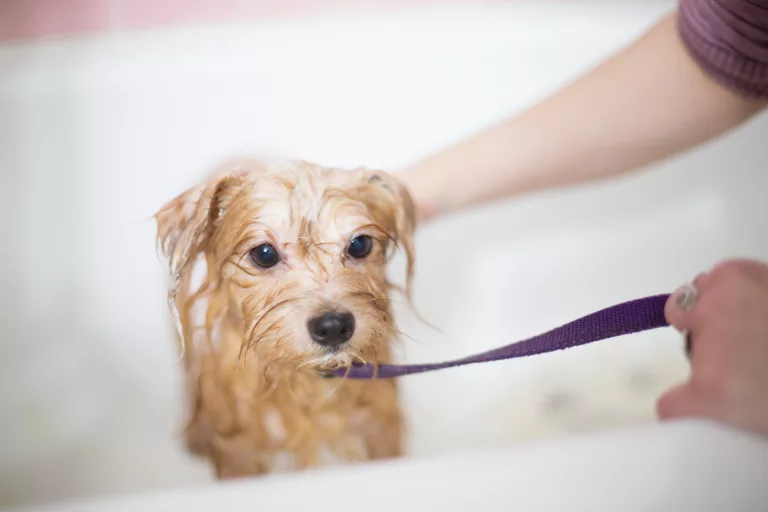
2. bathing your dog
How often your bathe your dog (if you should bathe them at all) depends on their specific breed.
Dogs such as Siberian Huskies or Golden Retrievers have a double coat with a water resistant outer coat and shouldn’t be bathed too much. Other breeds like Yorkshire Terriers may need nothing more regularly to help keep their coats tangle free.
The frequency of your dog can range from bathing every 2 months to only once every 6 months or when the coat gets noticeably dirty. Generally though, bathing a dog is usually more for the benefit of you than for your dog!
Here are some things to remember when bathing your dog at home:
- Use a special dog shampoo that is designed to treat your dog’s coat with a nice deep clean.
Organic natural shampoos are best for your dog’s coat, as they will clean your dog without covering the skin with any harmful chemicals which may cause irritation. We love So Fresh So Clean – Organic Dog & Puppy Shampoo. It’s totally natural and organic, so it’s completely free from any toxic chemicals that might dry out your dog’s skin.
- Introduce your dog to the water gently, letting them get comfortable with the water before you begin bathing.
- Use a water temperature that will not harm or distress your dog. Usually luke warm is perfect for your furry friend.
- Work the shampoo into a soapy lather as you massage the lather into your dog’s coat. Focus on areas that could be particularly dirty or smelly.
- After rinsing the soapy residue, dry your dog using a soft towel. If your dog doesn’t mind the noise, then you might choose to dry any excess using a hair dryer.
Remember that when grooming your dog at home it’s important to always put your dog’s health first. Do not bathe your dog too often, check the condition of your best friend’s coat first. If you notice that your dog’s skin is starting to dry out or your look irritated, you may be bathing your dog too often and stripping your dog’s coat of its natural oils. If in doubt, check with your professional dog groomer or veterinarian for advice.
3. TRIMMING YOUR DOG'S NAILS
Nail overgrowth can be very painful for your dog, so clipping their nails is important to include in the grooming routine you have with your pooch.
There are many tell-tale signs that your dog may need their nails trimming but the most obvious sign is that dog’s nails shouldn’t touch the floor when they stand. If you hear clicking sounds when they walk on hard flooring then their nails likely need a trim.
Other signs include paw chewing or licking, excessive scratching on floors or furniture and visible nail tears or splinters.
Some dog parents feel that they would rather leave clipping nails to a professional groomer however, if you are careful enough you can add this to your list when grooming your dog at home.
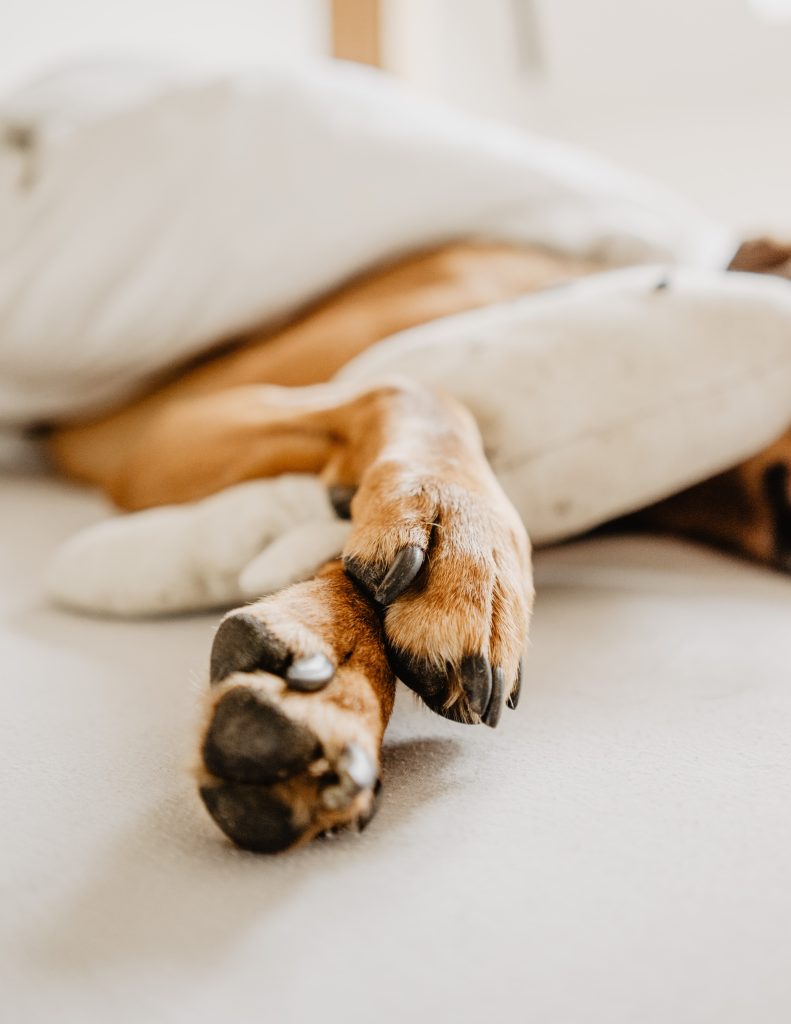
Some things to remember:
- Buy a specially made dog nail clipper or grinder, there are lots of choices online and you should pick the one that you feel most comfortable using.
- Make sure your dog is calm and relaxed, it’s very important to pick the right time and location to start grooming your dog at home.
- Be cautious about cutting too close to the quick of your dog. The quick is a pinkish part inside the nail which contains blood vessels and nerve endings. If you accidentally catch the quick when clipping it can be extremely painful to your dog. If your dog has dark nails you may not be able to see where the quick starts. With lighter nails, it’s easier to see where the quick begins. Avoid cutting too close to the quick.
- Clip your dog’s nails a small amount at a time. Gently hold your dog’s paws, separate the toes to expose the nail and trim carefully and gradually.
As you clip your dogs paws, it’s good practice to check for any damage to the pads too. And your dog would happily accept a paw massage with our very own Dog Paw and Nose Balm which moisturises paw pads, conditions skin and helps keep your dogs paws in top condition.
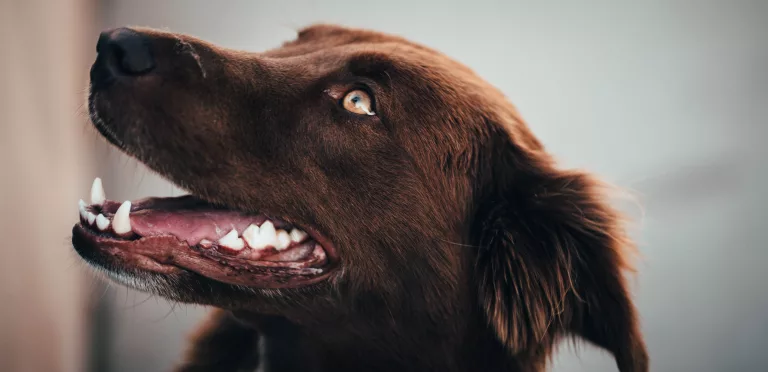
4. bRUSHING YOUR DOG'S TEETH
Just like us, dogs get build-up of plaque on their teeth. Regular brushing is recommended as part of a healthy grooming routine at home and it can help to prevent future dental problems like tartar build-up and gum disease. Good oral hygiene not only keeps your furry friend’s breath fresh but it can help avoid other problems around the body such as heart, liver and other organs too!
Choose a dog specific toothpaste
Do not use human toothpaste! Human toothpaste often contains an ingredient called xylitol which is poisonous for dogs. Instead, opt for a natural dog toothpaste like Natural Dog Toothpaste by Dogslife. It’s chemical free, and contains only natural ingredients.
Choose a dog toothbrush
We like this one from Petdentist because of the materials
they use. It has a bamboo handle and soft charcoal bristles. It’s biodegradable
and even vegan!
Brush the teeth slowly and gently
As always, make sure you’re in a safe, calm environment when your dog is relaxed and happy. Introduce the brush slowly to your dog, allowing them to get used to what the brush and toothpaste look, smell and feel like.
Gently expose your dogs teeth paying extra attention to the back molars (they tend to accumulate more plaque) Brush in circular motions on the visible teeth and gum line.
Find a routine that works for you and your dog
Maintaining consistency when grooming your dog at home will help improve the bond you both have together and keep your dog calm and relaxed when you repeat your grooming at home process. Aim to brush your dogs teeth around two to three times a week to maintain good dog dental hygiene.
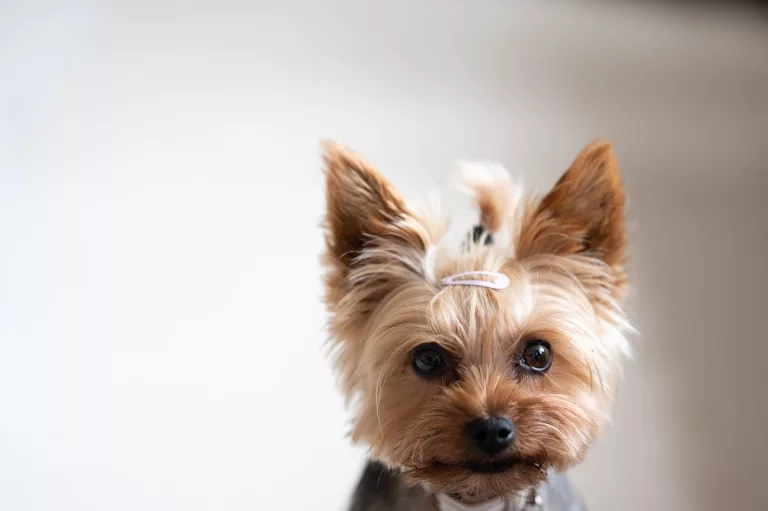
5. Trimming hair around the your dog’s ears
Inspecting your dog’s ears is an important part of grooming your dog and helps to keep your dog’s ears from getting infected or having other ear related problems.
Some dogs, especially those breeds with floppy ears, may have more hair growth within the ear that can sometimes cause irritation to the inner ear. It’s a good idea to trim the hair around the entrance to the ear to stop excess hair growth in this area.
Be careful though! Do not insert any cotton wool bud inside the ear canal as this can potentially damage your dog’s ear.
Check that the inside of the ear looks healthy. If you notice any unusual colour of the ear, any redness, swelling or discharge within the ear your dog may require veterinary attention.
6. and FINALLY...
It’s good practice when grooming your dog, to check over your dog’s whole body for any lumps and bumps, cuts and scrapes.
Regularly check the skin on your dog’s whole body including under the belly and between the paws. You can incorporate a relaxing doggy massage into the mix as you do this which will help calm and relax your dog and strengthen the bond you both have together.
If your dog shows signs of dry or cracked paws, a dry or cracked nose or any minor wounds, scrapes or abrasions, our Dog Paw and Nose Balm can help sooth irritated skin.
The ingredients within the balm have been specially formulated to assist in healing minor wounds and abrasions and the beeswax within it also creates a barrier that protects against the elements.
You can treat your dog to moisturised paws, a softer nose and quicker healing when needed with our dog balm.
And Rhoose Point Remedies Dog Paw and Nose Balm only contains 100% natural lick-safe ingredients, just in case your dog loves a good lick!
Treat your dog to a VIP dog grooming service every day!
For a natural dog grooming product that nurtures and protects your dog’s sensitive skin, try out our Dog Paw & Nose Balm today.
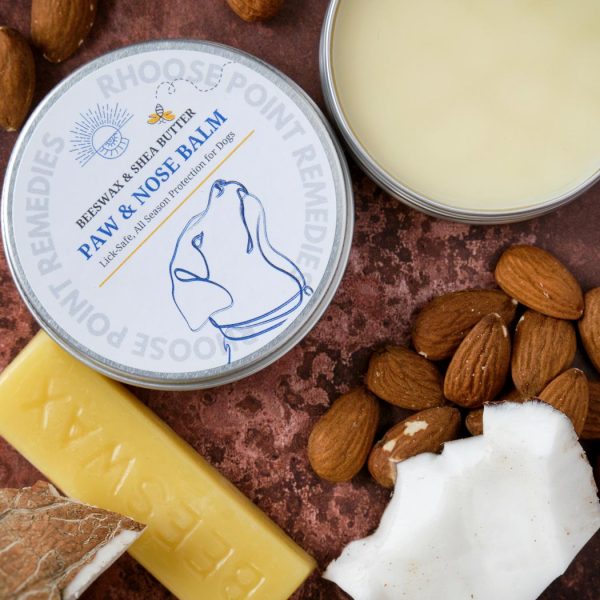
Dog Paw & Nose Balm by Rhoose Point Remedies
For more information about Rhoose Point Remedies’ Dog Paw & Nose Balm, take a look at our article here. It’s packed full of useful information – including a detailed ingredients list and application instructions.
